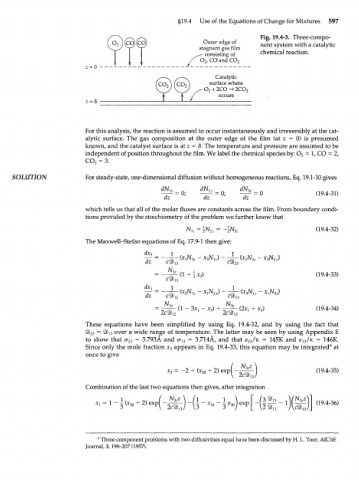Page 617 - Bird R.B. Transport phenomena
P. 617
§19.4 Use of the Equations of Change for Mixtures 597
Fig. 19.4-3. Three-compo-
Outer edge of nent system with a catalytic
stagnant gas film
- consisting of chemical reaction.
O , CO and CO
2 2
2 = 0
Catalytic
surface where
O + 2CO -+ 2CO 2
2
occurs
2 = 5
For this analysis, the reaction is assumed to occur instantaneously and irreversibly at the cat-
alytic surface. The gas composition at the outer edge of the film (at z = 0) is presumed
known, and the catalyst surface is at z = 8. The temperature and pressure are assumed to be
independent of position throughout the film. We label the chemical species by: O = 1, CO = 2,
2
CO = 3.
2
SOLUTION For steady-state, one-dimensional diffusion without homogeneous reactions, Eq. 19.1-10 gives
dN b dN 2z = 0; = 0
~dz~ = 0; dz dz (19.4-31)
which tells us that all of the molar fluxes are constants across the film. From boundary condi-
tions provided by the stoichiometry of the problem we further know that
(19.4-32)
The Maxwell-Stefan equations of Eq. 17.9-1 then give:
dx 3 1 -" x N, ) - 1
dz (*iN 3 2 3 z сЯЬ 23 (* 2 N 3 z -- x 3 N 2z )
N 3z
(19.4-33)
dx 1 1
x (x N -~ *iN 2 2 ) - *iN 32 )
dz c2&i, 2 u
(19.4-34)
These equations have been simplified by using Eq. 19.4-32, and by using the fact that
2) з ~ ^513 o v e r a wide range of temperature. The latter may be seen by using Appendix E
2
to show that a = 3.793A and a = 3.714A, and that S /K = 145K and е /к = 146К.
23 }3 23 и
Since only the mole fraction x appears in Eq. 19.4-33, this equation may be integrated 6 at
3
once to give
N z\
x = -2 + (x + 2) expl 3z (19.4-35)
30
3
2c% )
3
Combination of the last two equations then gives, after integration
Three-component problems with two diffusivities equal have been discussed by H. L. Toor, AIChE
6
Journal, 3,198-207 (1957).

